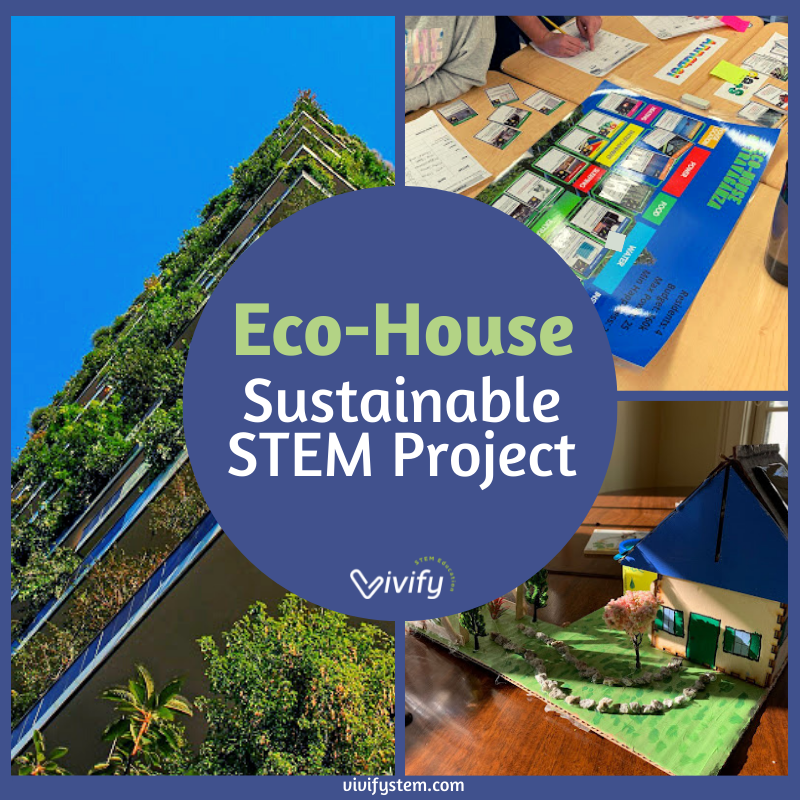Design a Sustainable Eco-House STEM Project
Post by Kristina Ohl
Originally Posted: June 1, 2022
Updated: March 2024
In the Eco-House Extravaganza STEM project, students work in teams to complete the ultimate project-based learning STEM experience: planning and designing an energy-efficient, eco-friendly house! Read below for how to implement a project that incorporates environmental and earth science, STEM careers, sustainability, and teamwork. This lesson was developed by a middle school science teacher and Harvard graduate student, Kristina Ohl, who shares her experience developing and testing out this lesson so you can bring it to your classroom!
Development of the Eco-House STEM Project
I am a 6th grade science teacher and, last fall, I decided to return to school to receive my M.Ed at the Harvard Graduate School of Education. While taking a class on constructionist learning, I decided to “re-create” one of my favorite class activities- the Mission to Mars STEM challenge by Vivify STEM! During the Mission to Mars project, students worked together to plan out and design colonies on Mars. This project was very successful with my students, and they told me how surprised they were with how much they learned about living in space. Most importantly, the project allowed students to tackle real-life, relevant challenges.
I hoped to help students see STEM as more applicable to their lives by exploring a relevant topic in engineering and climate change: designing sustainable, eco-friendly homes. The project-based curriculum that I adapted is intended to help students take on the role of sustainable building engineers as they go through the engineering design process.
Mission to Mars Planning Game, included in the Mission to Mars Semester STEM Unit! Click below to get yours and blast off to Mars!
Eco-House Project Overview
Designing by creating leads to deeper, more meaningful learning experiences. This project facilitates students’ construction of their own conceptual understandings by empowering them as apprentices in a field.
The Eco-House Extravaganza project is an opportunity to help students make personal connections to what they are learning by making it authentic to the work of actual engineers and building designers. While planning this project, I consulted with a sustainable building engineer who is a former researcher at the National Renewable Energy Laboratory. This allowed me to verify that all of the technology and sustainable building solutions are accurate and reflect real-world practices.
The week-long project walks students through planning and designing an energy-efficient, eco-friendly house in the U.S. city of their choice. A 5-E lesson plan is included to help teachers follow an inquiry-based approach. Students start by discussing the definition for the term “sustainable” and read about Earthship houses and Leed-certified buildings. Students also learn about the engineering design process and begin working in teams to identify the problem, brainstorm solutions, design, receive feedback, and redesign. The project culminates in students building prototypes and sharing solutions with their classmates.
Eco-House Planning Game
The highlight of the Eco-House STEM project is the planning game. This game helps students brainstorm engineering solutions to make their eco-houses as sustainable as possible. Students use game cards with information about various technologies as they consider the affordances and constraints of each engineering design choice. They must select options for insulation and heating, such as sheep’s wool insulation and passive solar heating, sources of power such as solar and wind, and even options for water recycling, including aquaponics and home sewage treatments. Students also must work within constraints such as working within a budget of $65,000 and a limited power supply.
Why Project-Based Learning (PBL)?
Today, teachers are pressured by a strong push for standardized assessment- which leads to surface-level learning for students focusing on rote memorization in siloed subjects. The result is that students are robbed of the opportunity to learn how to recognize underlying mechanisms and practices that connect to all disciplines and to learn from the iterative processes of creation and reflection. The Eco-House project is interdisciplinary, addressing topics in building science, financial budgeting and human impacts on the environment.
Additional Resources
Click here to access the Eco-House STEM Project lesson guide.
For more useful resources on sustainability and the environment, check out SubjectToClimate. This website connects teachers with free resources for teaching about climate change. It offers lesson plans and a resource database, as well as student-friendly news articles about climate change.
More resources:
The Mars Colony Design Challenge provided lasting memories for my students, and I am already witnessing the impact that the Eco-House STEM Project can have as well. Students in 5th and 4th grade were completely overjoyed to test out my planning game. They begged their teacher to let them complete the entire project! I am eager to share this project with many more teachers, and I am excited to see how I can continue to develop the project further.





